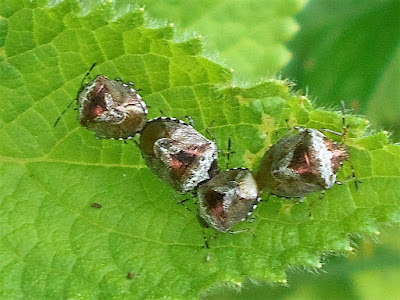A potential problem did present itself as it appeared that a bull was in residence but, if it was, it was a shy creature for I saw nothing of it.
The area I had deemed worth revisiting consisted of a rather wet strip of land bordering a stream - a tributary of the Cherwell - but following a very dry spring conditions underfoot were quite good.
 |
Many species of insect inhabited this lush grass. Gravel Farm,
Woodford Halse. 31 May, 2017
|
Fifty years ago land of this kind would probably have supported a lovely display of flowers but today, apart from lush grasses and spiky rushes the only splash of colour was provided by buttercups and a few clumps of Red Campion, Silene dioica.
 |
Only a few Red Campions were to be found.
Gravel Farm, Woodford Halse.
|
I observed the campions for a while but they had no visitors. Nor did I pluck a bloom; it was once believed to be a Devil's plant which, if picked, would lead to an untimely death. The buttercups on the other hand were very popular and frequent among those dropping in were Downlooker Snipeflies, Rhagio scolopaceus.
 |
Downlooker Snipefly on buttercup. Woodford Halse, Northants.
31 May, 2017
|
They get their odd name from their habit of sitting on tree trunks and taking up a 'down-looker' pose. Although all have some sort of dark wing marking there is a certain amount of variation.
 |
Another specimen of the same species, Rhagio scolopaceus,
from the same location.
|
There are lots of Carpet moths in Britain (not to be confused with creatures notorious for damaging carpets) and they can be a little confusing. However this one is easy is easy. It is a Silver-ground Carpet, Xanthorhoe montanata. It is common and its caterpillars feed on bedstraws. I disturbed this one from tall grass.
 |
Silver-ground Carpet at Gravel farm, Woodford Halse.
31 May, 2017
|
The Click Beetles are notorious because their larvae, known as wireworms, are responsible for considerable damage to crops, feeding on the plant roots. The adults, when disturbed, spring into the air with an audible click and fall to the ground where, being mostly of a drab brown colour, they are almost impossible to find. I spotted this very common one, Athous haemorrhoidalis, sitting on a nettle leaf (to be clear, it was the beetle sitting on the leaf; I was standing on the farm track).
 |
A click beetle. This species is Athous haemorrhoidalis. Gravel Farm,
Woodford Halse. 31 May, 2017
|
At this point I was joined by a small group of sheep, clearly confused and indignant. What was I doing and why was I on their land? They observed me philosophically for a few minutes and then commenced grazing, determined to feign insouciance.
 |
Who's the crazy guy with the net? Woodford Halse.
31 May, 2017
|
I continued, now concentrating on the hedgerow where a few Woundwort plants, not yet in flower, were hosting - surprise, surprise - some Woundwort Bugs, Eysarcoris venustissima. To us the Hedge Woundwort, Stachys sylvatica, has a foul smell but for this charming little bug it is the flower of choice, for it seems to occur on this plant only.
 |
Woundwort bugs in copula. Gravel Farm, Woodford Halse, Northants.
31 May, 2017
|
'Bloodsuckers' abounded. By this I refer to Soldier Beetles, Cantharidae. For us as children, perhaps because of the reddish colour, they always has this scary name and clearly the name is widespread; apparently in Scotland they are called 'souk-the bluid', although in reality they are harmless pollen feeders. Strictly speaking the name bloodsucker should apparently be applied to Rhagonycha fulva but as kids we didn't recognise these niceties. The species photographed is Cantharis rufa.
 |
A soldier beetle. This one is Cantharis rufa. Gravel farm, Woodford Halse.
31 May, 2017
|
At this point I decided that lunch was calling and I retraced my steps, leaving the sheep to relax. I paused for a moment to photograph the dainty but generally overlooked Lesser Stitchwort, Stellaria graminea, and set off for home.
 |
Lesser Stitchwort, common in pastures nationwide. Gravel Farm,
Woodford Halse, Northants. 31 May, 2017
|


No comments:
Post a Comment